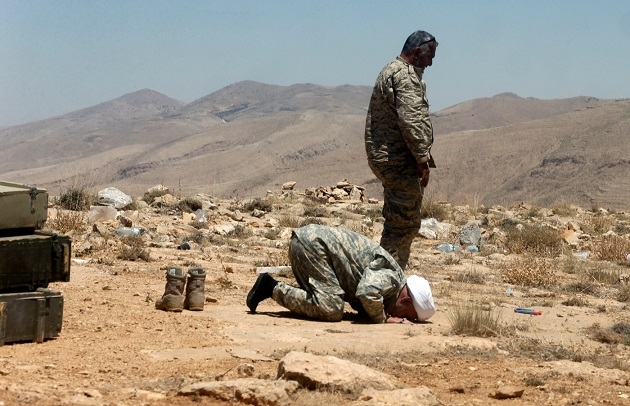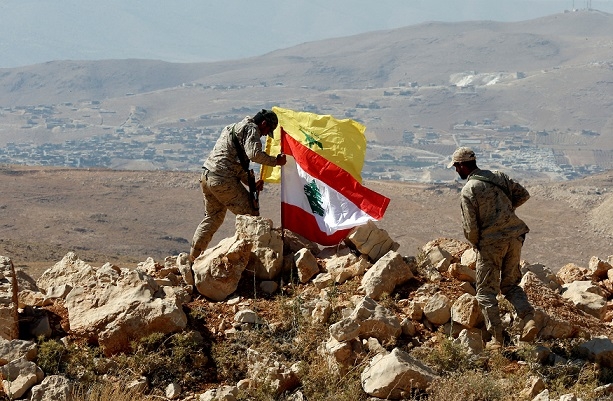After Arsal: Hezbollah's new triangle of influence

After years of attempts to eject Syrian militants from a mountainous area in eastern Lebanon, Hezbollah announced late on Wednesday that the Jabhat Fatah al-Sham (JFS) chapter in the country is closed.
“We are in the face of a very big military victory,” Hassan Nasrallah said in a televised speech, hours before the ceasefire between his group and JFS went into effect early Thursday morning.
Fighters from JFS, the former al-Qaeda affiliate once known as Jabhat al-Nusra, and their families will be sent to Idlib according to the terms of the ceasefire agreement.
A week ago, the group launched its military operation in the area surrounding the town of Arsal, which has been a hotbed for Syrian militants since the onset of the revolution.
The campaign has come as the de-escalation of the war inside Syria has allowed Hezbollah to redeploy troops to attack the exhausted remaining fighters in the area and complete its monopoly over a Syrian expanse stretching from Qassayr to Zabadani.
In recent days, Hezbollah has claimed that it has captured what would be 80 percent of the area and warned remaining fighters, in an ultimatum released on Monday, that the fight was nearing its end.
By the time the ceasefire was announced on Wednesday, the militants were surrounded to the west by Lebanese outposts and watchtowers, and by Hezbollah positions on the south and north, making it only a matter of time before the group completed its mission.Now Hezbollah's battle - carried on without the Lebanese army which maintains a neutral stance on the Syrian conflict - is expected to target members of the Islamic State group who remain.
Completely securing the area would be a major moral and strategic victory for the group - and, after PM Saad Hariri this week called Hezbollah's operation "illegitimate", will raise tensions in Lebanon over control of the state's sovereignty.
Smuggling hub
Since 2011, Arsal, located in the Bekaa Valley, has been a smuggling hub for Syrian militants of all sorts.
Given its central role in defending the Assad regime, Hezbollah became a target for various Syrian rebel groups and later Nusra, which became JFS, and the Islamic State (IS).
Between 2013 and 2014, Arsal, which is populated mostly by Sunnis who support the Syrian revolution, became a transit point for many of the booby-trapped cars that targeted the group’s strongholds in Lebanon.
More than 100 people were killed and hundreds more wounded in more than a dozen suicide bombing attacks on Shia-populated areas in 2013 and 2014, according to Jane’s Defence. Investigations showed at the time that vehicle bombs were put together in the Syria border region before being driven into Lebanon for the attacks.
More than 18 additional suicide attacks have also taken place in Lebanon since 2013. Recent attacks such as Qaa in 2016, Bourj Barajneh in 2015 and earlier in 2014 against the Duroy Hotel in Beirut were claimed by IS. Many of these attacks are thought to have involved individuals who passed through Arsal.
The holdouts and the stranded
Arsal is home today to at least 50,000 Syria refugees. “Many of them are related to the remaining IS and JN fighters located in the mountainous areas,” says an officer of the Lebanese army speaking on condition of anonymity.
However, residents in the town – including those in camps who reportedly raised Lebanese flags in support of Lebanese sovereignty as the campaign got underway – told MEE that they are terrified of what the militants will do and refused to join the fight when a JFS supporter tried to recruit them over a megaphone.
Earlier in the year, Hezbollah entered negotiations to secure the evacuation of refugees and some militants back to Syria ahead of a final push to regain the area.
According to Arsal activist Abou Mohamad Ali Ouweid, the negotiations also allowed for the evacuation of 100 or so Free Syrian Army fighters leaving around 400 remaining fighters exhausted by a long siege.
“There are a few hundred of them currently engaged in the fight against Hezbollah in a small stretch of area between Lebanon and Syria,” says the Lebanese army officer.
Growing impatience
Hezbollah’s impatience with the situation in Arsal was clearly highlighted by an 11 July speech by its general secretary Sayed Hassan Nasrallah. “The threat still exists on [Arsal’s] outskirts and this matter needs a solution,” he said.
The timing of Hezbollah’s military operation also appears to be linked to recent developments in Syria and to Hezbollah's strategic calculations.
As a result of the deal, Hezbollah was forced to retreat from the area, giving it an opportunity to use its forces to inflict a final onslaught to the militants in the border region between Syria and Lebanon.
In addition to clearing the hotbed of insurgency, Hezbollah has other important strategic calculations in this peripheral region. Over the past two years, it has carved a militarised zone for itself, stretching from Qassayr in northeast Lebanon to Zabadani in the south of Syria.
Once Hezbollah completes its capture of the mountainous area, it will have uninterrupted control over the Syrian side of the border in a triangle that stretches to Homs and Damascus, points out anti-Hezbollah activist Ali Amine who has been following the situation.
Nasrallah has promised that once Arsal is completely in the group’s control, they will hand it over to the Lebanese army.
After all, Hezbollah’s new, unchallenged border bastion will provide the group with a large military reach and incomparable leverage into neighbouring Syria. Whether the group will actually surrender the territory remains to be seen.
- Mona Alami is a researcher and journalist covering Levant politics. She is a non-resident-fellow at the Atlantic Council. Her primary focus is radical organisations. She holds a BA and an MBA in management.
The views expressed in this article belong to the author and do not necessarily reflect the editorial policy of Middle East Eye.
Photo: Hezbollah fighters pray at Juroud Arsal on the Syria-Lebanon border on 25 July 2017 (AFP)
This article is available in French on Middle East Eye French edition.
New MEE newsletter: Jerusalem Dispatch
Sign up to get the latest insights and analysis on Israel-Palestine, alongside Turkey Unpacked and other MEE newsletters
Middle East Eye delivers independent and unrivalled coverage and analysis of the Middle East, North Africa and beyond. To learn more about republishing this content and the associated fees, please fill out this form. More about MEE can be found here.








